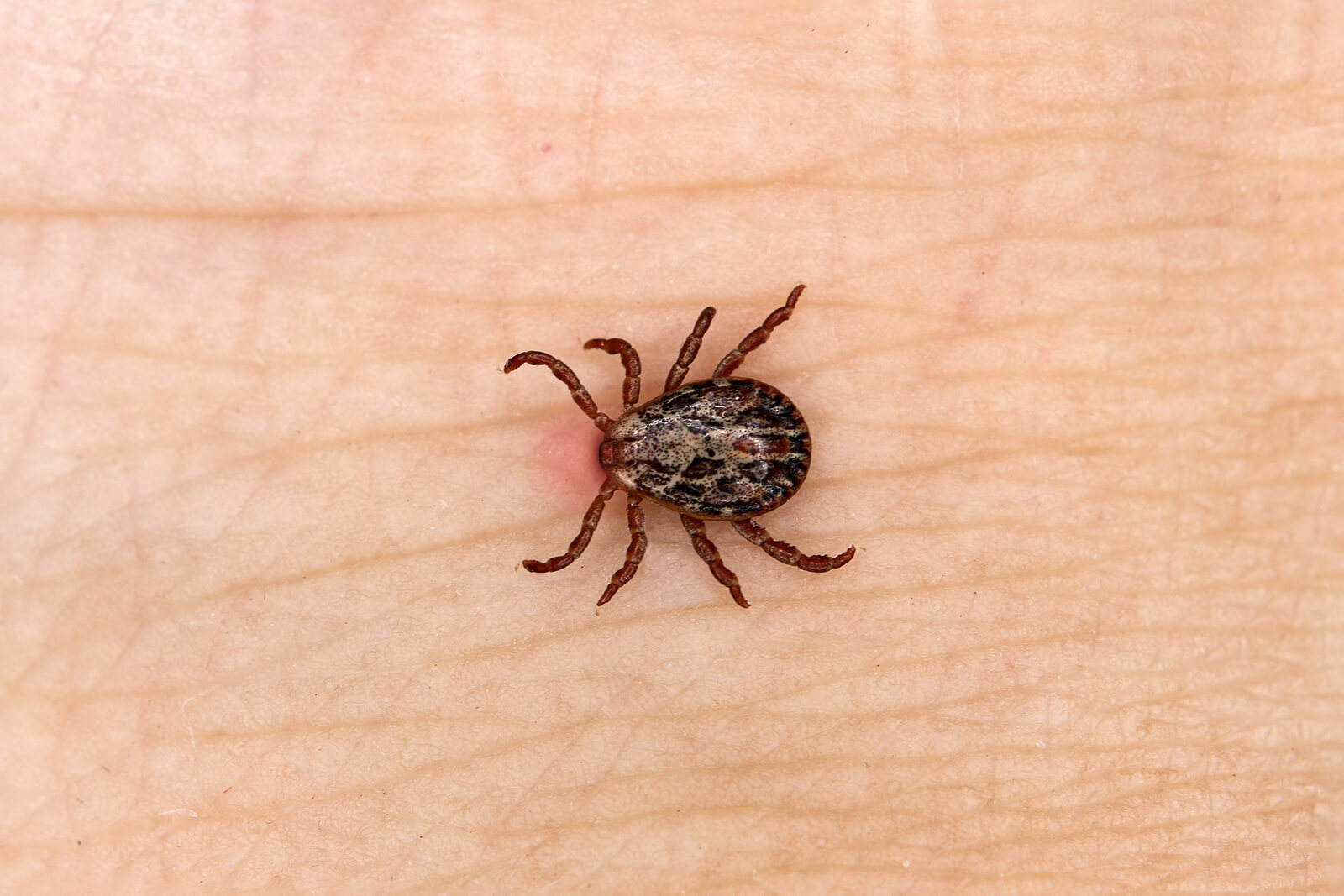Causes and Risk Factors of Lyme Disease

Some viruses and bacteria are capable of reproducing inside insects and arthropods that feed on blood. In this way, they’re capable of infecting humans when the insect feeds on them, thus causing disease. One of the pathologies that’s transmitted in this way is Lyme disease, and in this article we’ll be discussing its causes and risk factors.
Lyme disease is an infection caused by a specific type of bacteria called a spirochete, which is capable of affecting certain ticks. Studies show that it’s endemic in Europe, affecting between 8% and 27% of forest workers in countries such as the Netherlands and Germany.
Causes of Lyme disease

Generally speaking, it’s a rare infection in the general population, only affecting certain people with a high level of exposure. Fortunately, the causes and risk factors for Lyme disease are well described, so appropriate measures can be taken to prevent it.
The transmission of the disease is directly through the bite of contaminated ticks. In this sense, no cases of human-to-human or animal-to-human transmission have been encountered to date. Nor have there been reports of transmission during breastfeeding, blood transfusion, or sexual contact.
Infected tick bite
For a person to develop the disease, it must be bitten by a tick contaminated with a spirochete of the genus Borrelia. Studies determine that the causal agent may vary depending on the geographical location, with B. burgdorferi being the most frequent in the Americas, while in Asia and Europe it may also be due to B. afzelii and B. garinii.
We should highlight that not just any arthropod can transmit the disease. In this sense, the ticks that function as a vector are mainly those belonging to the genus Ixodes, also known as hard ticks. The specific species also varies according to the region, in the United States, I. scapularis is more frequent, while in Europe it’s I. ricinus.
Bacteria of the genus Borrelia usually infect certain field animals such as white-footed mice, sheep, and other small mammals, which function as a reservoir. This means that they’re infected by the bacteria without suffering from the disease. Ticks usually become infected when feeding on these animals, making it possible for them to transmit the disease to humans by biting them.
Tick bites can be difficult to notice, allowing them to stick to the skin long enough to infect the host. A tick must feed between 36 and 48 hours to transmit the disease. However, the first symptoms such as erythema and fever can take weeks to appear.
Risk factors for Lyme disease
By knowing the causes of Lyme disease, you can quickly determine your risk factors for the disease. In this sense, people who live in regions close to forests or the countryside have a greater risk of suffering from the infection. This is because the reservoirs and vectors of the pathology are abundant in these areas.
On the other hand, the disease is more common during the summer or in the warmer months of the year, because people are more active. During these months, it’s common to carry out outdoor activities, which predisposes the population to suffer certain infectious diseases, including Lyme disease. Other risk factors that should be highlighted are the following:
- Working or spending a lot of time in wooded or overgrown regions
- Have pets like cats and dogs
- Doing activities in the forest such as hunting or camping
- Being in constant contact with animals that can serve as a reservoir
- Having very exposed skin when outdoors
- Failure to remove attached ticks properly
When to consult the doctor?

Not all tick bites will transmit Lyme disease. In this sense, it will only be necessary to see a doctor when abnormal symptoms occur after a tick bite. The first symptoms may disappear on their own after a few days, however, this doesn’t mean that the disease has disappeared.
Treatment of the infection is much more effective if it begins during the early localized stage of the disease, so an early diagnosis is essential. When left untreated, the disease can lead to certain complications such as arthritis, neurological conditions, and even increase the risk of fibromyalgia.
Prevention is essential
Lyme disease prevention measures consist of eliminating existing causes and risk factors. In this sense, wooded areas where the disease is endemic should be avoided. When this isn’t possible, you should avoid having very exposed skin and use insect repellent to reduce the risk of infection.
In the event of a bite, the most important thing is to remove the tick correctly as soon as possible, without squashing it and avoiding leaving any part attached to the skin. Fortunately, the treatment of the disease is effective, requiring only the use of certain antibiotics such as doxycycline or amoxicillin.
Some viruses and bacteria are capable of reproducing inside insects and arthropods that feed on blood. In this way, they’re capable of infecting humans when the insect feeds on them, thus causing disease. One of the pathologies that’s transmitted in this way is Lyme disease, and in this article we’ll be discussing its causes and risk factors.
Lyme disease is an infection caused by a specific type of bacteria called a spirochete, which is capable of affecting certain ticks. Studies show that it’s endemic in Europe, affecting between 8% and 27% of forest workers in countries such as the Netherlands and Germany.
Causes of Lyme disease

Generally speaking, it’s a rare infection in the general population, only affecting certain people with a high level of exposure. Fortunately, the causes and risk factors for Lyme disease are well described, so appropriate measures can be taken to prevent it.
The transmission of the disease is directly through the bite of contaminated ticks. In this sense, no cases of human-to-human or animal-to-human transmission have been encountered to date. Nor have there been reports of transmission during breastfeeding, blood transfusion, or sexual contact.
Infected tick bite
For a person to develop the disease, it must be bitten by a tick contaminated with a spirochete of the genus Borrelia. Studies determine that the causal agent may vary depending on the geographical location, with B. burgdorferi being the most frequent in the Americas, while in Asia and Europe it may also be due to B. afzelii and B. garinii.
We should highlight that not just any arthropod can transmit the disease. In this sense, the ticks that function as a vector are mainly those belonging to the genus Ixodes, also known as hard ticks. The specific species also varies according to the region, in the United States, I. scapularis is more frequent, while in Europe it’s I. ricinus.
Bacteria of the genus Borrelia usually infect certain field animals such as white-footed mice, sheep, and other small mammals, which function as a reservoir. This means that they’re infected by the bacteria without suffering from the disease. Ticks usually become infected when feeding on these animals, making it possible for them to transmit the disease to humans by biting them.
Tick bites can be difficult to notice, allowing them to stick to the skin long enough to infect the host. A tick must feed between 36 and 48 hours to transmit the disease. However, the first symptoms such as erythema and fever can take weeks to appear.
Risk factors for Lyme disease
By knowing the causes of Lyme disease, you can quickly determine your risk factors for the disease. In this sense, people who live in regions close to forests or the countryside have a greater risk of suffering from the infection. This is because the reservoirs and vectors of the pathology are abundant in these areas.
On the other hand, the disease is more common during the summer or in the warmer months of the year, because people are more active. During these months, it’s common to carry out outdoor activities, which predisposes the population to suffer certain infectious diseases, including Lyme disease. Other risk factors that should be highlighted are the following:
- Working or spending a lot of time in wooded or overgrown regions
- Have pets like cats and dogs
- Doing activities in the forest such as hunting or camping
- Being in constant contact with animals that can serve as a reservoir
- Having very exposed skin when outdoors
- Failure to remove attached ticks properly
When to consult the doctor?

Not all tick bites will transmit Lyme disease. In this sense, it will only be necessary to see a doctor when abnormal symptoms occur after a tick bite. The first symptoms may disappear on their own after a few days, however, this doesn’t mean that the disease has disappeared.
Treatment of the infection is much more effective if it begins during the early localized stage of the disease, so an early diagnosis is essential. When left untreated, the disease can lead to certain complications such as arthritis, neurological conditions, and even increase the risk of fibromyalgia.
Prevention is essential
Lyme disease prevention measures consist of eliminating existing causes and risk factors. In this sense, wooded areas where the disease is endemic should be avoided. When this isn’t possible, you should avoid having very exposed skin and use insect repellent to reduce the risk of infection.
In the event of a bite, the most important thing is to remove the tick correctly as soon as possible, without squashing it and avoiding leaving any part attached to the skin. Fortunately, the treatment of the disease is effective, requiring only the use of certain antibiotics such as doxycycline or amoxicillin.
- García Meléndez M, Skinner Taylor C, Salas Alanís J, Ocampo Candiani J. Enfermedad de Lyme: actualizaciones. Gaceta Médica de México. 2014;150:84-95.
- Chomel B. Lyme disease. Rev Sci Tech. 2015;34(2):569-76.
- Ross Russell A, Dryden M, Pinto A, Lovett J. Lyme disease: diagnosis and management. Pract Neurol. 2018;18(6):455-464.
- Mead PS. Epidemiology of Lyme disease. Infect Dis Clin North Am. 2015;29(2):187-210.
- Carriveau A, Poole H, Thomas A. Lyme Disease. Nurs Clin North Am. 2019;54(2):261-275.
- Schoen RT. Lyme disease: diagnosis and treatment. Curr Opin Rheumatol. 2020;32(3):247-254.
Este texto se ofrece únicamente con propósitos informativos y no reemplaza la consulta con un profesional. Ante dudas, consulta a tu especialista.







